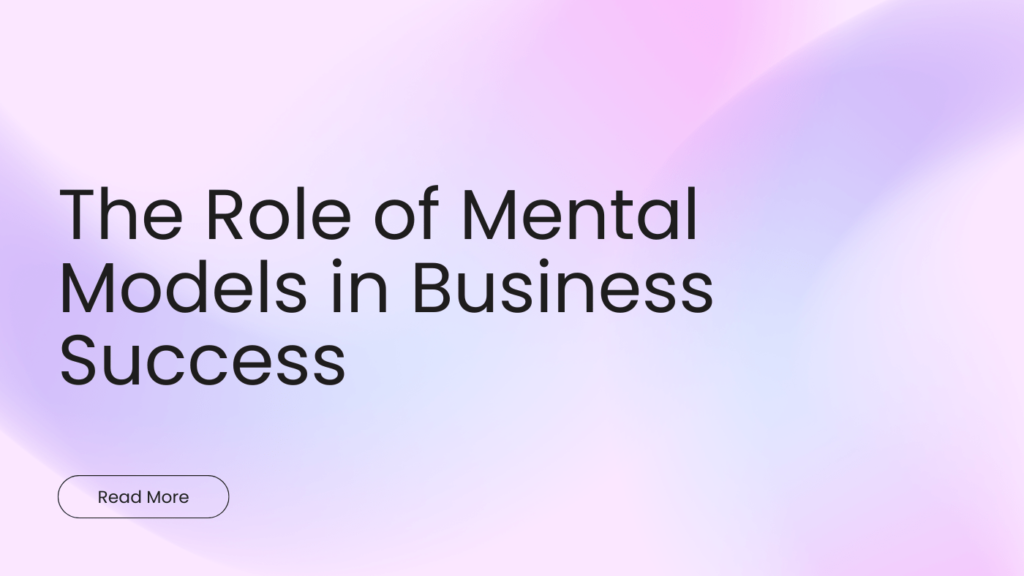The Role of Mental Models in Business Success: A Comprehensive Guide
In the complex and ever-evolving world of business, success often hinges on the ability to make sound decisions, navigate uncertainty, and adapt to change. While experience and expertise are undoubtedly valuable, a powerful but often overlooked tool can significantly enhance your business acumen: mental models.
This comprehensive guide explores the crucial role of mental models in achieving business success. We’ll delve into what they are, how they work, and, most importantly, how you can leverage them to improve your decision-making, strategy, and overall business performance. We’ll examine using mental models in business to solve problems and create robust strategies.
What are Mental Models?
At their core, mental models are simplified representations of how something works. They are frameworks that help us understand and interact with the world around us. Think of them as internal, working theories about cause and effect, relationships, and processes. They allow us to predict outcomes, explain phenomena, and make informed decisions.
As Scott E. Page explains in his book, “The Model Thinker: What You Need to Know to Make Data Work for You”, “A model is a simplified representation of the world used to make predictions or explain phenomena.” This simplification is key. The world is too complex to grasp in its entirety, so we rely on models to filter out noise and focus on the essential elements.
In essence, mental models are the lenses through which we see the world and make decisions.
Why Mental Models Matter in Business
The benefits of employing mental models in business decision making models are numerous. They provide a structured way to analyze complex situations, challenge assumptions, and develop more robust strategies. Here are a few key reasons why mental models are essential for business success:
* **Improved Decision Making:** Mental models provide frameworks for analyzing situations from multiple perspectives, leading to more informed and well-reasoned decisions.
* **Enhanced Problem Solving:** By understanding the underlying dynamics of a problem, mental models can help you identify root causes and develop effective solutions.
* **Strategic Thinking:** Mental models enable you to anticipate potential challenges and opportunities, allowing you to develop proactive strategies.
* **Risk Management:** By considering different scenarios and potential consequences, mental models can help you assess and mitigate risks.
* **Innovation:** Mental models can spark new ideas by challenging conventional thinking and prompting you to explore alternative approaches.
* **Better Communication:** Shared mental models within a team can foster better understanding and collaboration.
Key Mental Models for Business
While countless mental models exist, some are particularly relevant and valuable for business leaders and professionals. Here are a few examples:
* **First Principles Thinking:** Breaking down a problem to its fundamental truths and building up from there, rather than relying on assumptions or analogies. Elon Musk is a proponent of this, often using it to innovate in fields like aerospace and automotive.
* **Occam’s Razor:** The simplest explanation is usually the best. This encourages you to avoid unnecessary complexity and focus on the most likely solution.
* **Inversion:** Instead of focusing on how to achieve a goal, consider how to fail. This can help you identify potential pitfalls and develop strategies to avoid them.
* **Second-Order Thinking:** Considering the consequences of the consequences. This encourages you to think beyond the immediate impact of a decision and anticipate its ripple effects. As Peter Kaufman often says, thinking through the consequences of the consequences is critical.
* **Supply and Demand:** A foundational economic principle describing the relationship between the availability of a product and the desire for that product. Understanding this relationship is crucial for pricing, production, and inventory management.
* **Network Effects:** The value of a product or service increases as more people use it. This model is particularly relevant for businesses with a large user base, such as social media platforms.
* **Compounding:** Small, consistent improvements over time can lead to significant results. This model applies to everything from financial investments to skill development. This is also critical for company culture, where small daily actions can compound into significant outcomes.
* **The 80/20 Rule (Pareto Principle):** Roughly 80% of effects come from 20% of causes. This model helps you prioritize your efforts and focus on the most impactful activities.
* **Opportunity Cost:** The potential benefit that is forfeited by choosing one alternative over another. Understanding opportunity cost helps you make informed decisions about resource allocation.
How to Apply Mental Models in Business
Simply knowing about mental models isn’t enough. You need to actively integrate them into your decision-making process. Here’s a practical guide to using mental models in business:
1. **Identify the Problem or Challenge:** Clearly define the issue you’re trying to address.
2. **Select Relevant Mental Models:** Consider which mental models might be helpful in understanding the problem. Don’t be afraid to use multiple models.
3. **Analyze the Situation:** Apply the chosen mental models to the situation, considering different perspectives and potential outcomes.
4. **Challenge Assumptions:** Question your own biases and assumptions. Are you relying on outdated information or flawed logic?
5. **Generate Potential Solutions:** Brainstorm different solutions based on your analysis.
6. **Evaluate the Solutions:** Assess the potential risks and rewards of each solution, considering second-order effects.
7. **Make a Decision:** Choose the solution that best aligns with your goals and values.
8. **Review and Adapt:** Monitor the results of your decision and be prepared to adjust your approach as needed.
Examples of Mental Models in Action
* **Netflix using First Principles Thinking:** Instead of assuming they needed to continue with the traditional DVD rental model, Netflix used first principles to realize they could stream content over the internet, revolutionizing the entertainment industry.
* **Amazon using the Flywheel Effect:** Amazon built a powerful growth engine by focusing on low prices, customer experience, and seller selection. Each element reinforces the others, creating a self-sustaining cycle of growth.
* **Zara using Quick Feedback Loops:** Zara’s fast fashion model relies on quickly gathering customer feedback and adapting its designs and production accordingly, minimizing inventory risk and maximizing responsiveness to trends.
Cultivating a Mental Model Mindset
Developing a strong mental model toolkit is an ongoing process. Here are some tips for cultivating a mental model mindset:
* **Read Widely:** Explore different disciplines, including science, history, economics, and psychology.
* **Seek Diverse Perspectives:** Talk to people with different backgrounds and experiences.
* **Question Everything:** Challenge your own assumptions and biases.
* **Learn from Mistakes:** Analyze your past decisions and identify areas for improvement.
* **Practice Deliberate Thinking:** Take the time to think through complex problems carefully.
* **Document Your Learning:** Keep a journal or notebook to record your insights and reflections.
The Importance of Diverse Mental Models
Relying on a limited set of mental models can lead to narrow thinking and flawed decisions. It’s crucial to cultivate a diverse toolkit of mental models to approach problems from multiple angles. Having varied business decision making models available improves strategy.
As Charlie Munger, Warren Buffett’s long-time business partner, famously said, “You’ve got to have models in your head. And you’ve got to array your experience both vicarious and direct on this latticework of models.”
The more mental models you have, the better equipped you’ll be to understand the complexities of the business world and make informed decisions.
Conclusion: Mental Models as a Competitive Advantage
In today’s competitive business landscape, having a solid understanding of mental models and being able to effectively apply them is a significant advantage. By incorporating these frameworks into your decision-making process, you can enhance your strategic thinking, improve your problem-solving abilities, and ultimately drive business success.
Embrace the power of mental models, and unlock your potential to make smarter decisions, navigate uncertainty, and thrive in the ever-changing world of business. Remember that using mental models in business isn’t just a tactic, it is a strategy to develop robust and adaptive business leadership. Start building your mental model toolkit today!
“`


